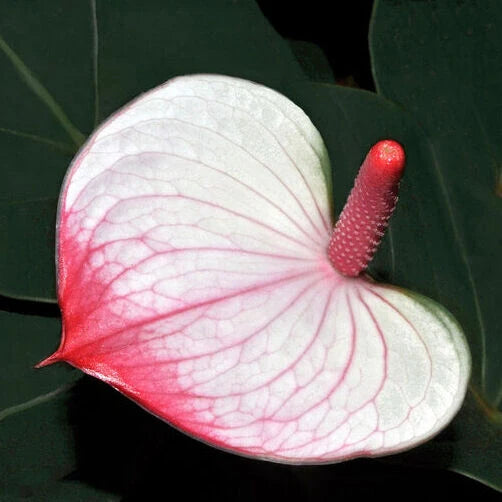
Anthurium Princess Amalia Elegance
Selling size: Single plant | 2.5″ Pot Included | Secure Packing
The Anthurium Princess Amalia Elegance is a beautiful and relatively easy-to-care-for houseplant, known for its striking heart-shaped "flowers" (actually modified leaves called spathes) that transition from deep pink to soft white.
Here's a Anthurium Princess Amalia Elegance comprehensive care guide:
1. Light:
Bright, indirect light is ideal. Mimic its natural jungle habitat where it receives dappled sunlight through a canopy.
Avoid direct sunlight, especially harsh afternoon sun, as it can scorch the leaves. A north or east-facing window is often perfect.
While it can adapt to medium or even low light, brighter indirect light will encourage more blooms.
2. Watering:
Water when the top 50-75% of the soil (or top 1-2 inches) is dry to the touch. You can use the "finger dip test" to check.
Water thoroughly until liquid flows through the drainage hole.
Ensure good drainage and discard any excess water from the saucer. Anthuriums are susceptible to root rot if left in standing water.
Avoid both overwatering (which leads to yellow leaf tips) and underwatering (which causes brown leaf tips).
3. Humidity:
Anthuriums are tropical plants and thrive in high humidity (50% or more).
Mist the leaves regularly (daily or every few days, especially in drier climates or during winter).
Consider using a pebble tray filled with water (ensure the pot isn't sitting directly in the water) or a room humidifier to increase ambient humidity.
A steamy bathroom can also be a good spot for them.
4. Temperature:
They prefer average to warm temperatures, ideally between 65-80°F (18-27°C).
Avoid temperatures below 60°F (15°C), as this can damage the plant and halt growth.
Keep your plant away from cold drafts, heating and air conditioning vents, or fans, which can cause temperature fluctuations.
5. Soil:
Anthuriums need a well-draining potting mix that also retains some moisture.
A good mix often includes a combination of peat moss, perlite, and orchid bark.
Some sources suggest a 50-50 mix of orchid potting media and houseplant potting soil.
Cococopit or cocochips can also be excellent media for anthuriums.
6. Fertilizer:
Feed your Anthurium 'Princess Amalia Elegance' during the growing season (spring and summer).
Use a balanced liquid fertilizer, or one specifically formulated for anthuriums, diluted to half the recommended strength.
Apply fertilizer every 2-4 weeks or every month.
Never apply fertilizer to dry soil to avoid root burn.
Reduce or stop fertilizing during the fall and winter months when the plant's growth slows down.
7. Potting and Repotting:
Repot your Anthurium every 1-2 years in the spring, or when it outgrows its current pot.
Choose a pot that is only slightly larger and has good drainage holes.
Anthuriums are slow growers, so they don't need frequent repotting.
You might see "aerial roots" growing from the stems; these are normal and help the plant grip onto other surfaces in its natural habitat. You can snip them off if they bother you, it won't harm the plant.
8. Pruning:
Remove any dead, yellowing leaves, or spent flowers regularly. Pinch them off at the base or use sterile pruning shears. This encourages new growth and maintains the plant's appearance.
You can also prune to shape the plant any time of year, removing overly tall stems or those growing at odd angles. Always leave at least 3-4 leaves on the plant.
9. Pests and Diseases:
Keep an eye out for common houseplant pests like aphids, mealybugs, and spider mites.
Treat infestations promptly with insecticidal soap or neem oil.
Ensure good air circulation around the plant to prevent fungal diseases.
Dust the leaves gently with a damp cloth regularly to improve photosynthesis and remove dust.
10. Toxicity:
Anthuriums are considered toxic to pets and humans if ingested. Their sap can irritate skin and eyes, and the leaves are poisonous if eaten.
Keep your 'Princess Amalia Elegance' in a safe place away from curious pets and children.
By providing these ideal conditions, your Anthurium 'Princess Amalia Elegance' should thrive and reward you with its beautiful, long-lasting blooms!

